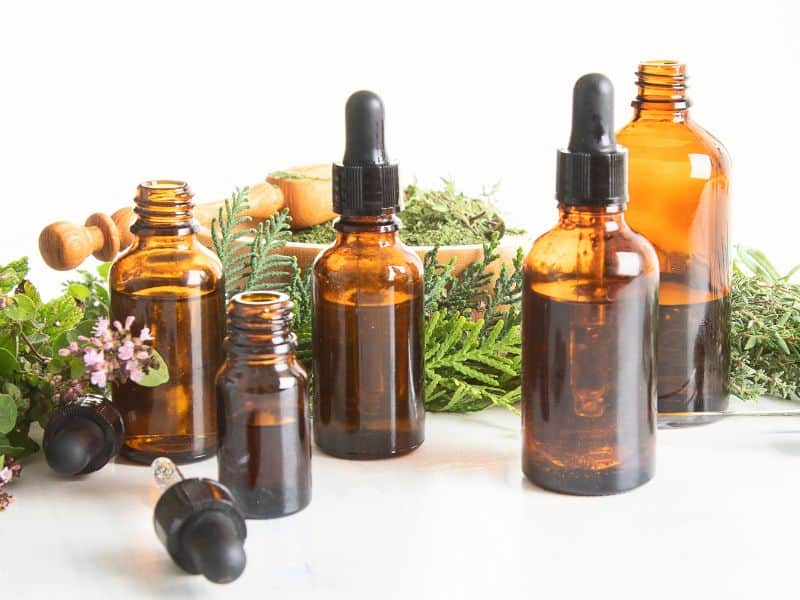Essential oils have become increasingly popular in soap-making, thanks to their enticing fragrances and therapeutic properties. While these concentrated plant extracts can elevate the sensory experience and benefits of handmade soaps, it’s crucial to put too much essential oil in soap.
Too much essential oil in soap can cause skin irritation, overpowering fragrance, reduced lather, poor texture, and shortened shelf life. It’s crucial to follow recommended essential oil concentrations to ensure a safe, enjoyable, and effective soap.
If you’re using a pre-made soap recipe, it’s best to stick with the measurements given for essential oils. However, if you want to adjust them, use caution and start by increasing them incrementally until you reach your desired level of fragrance. Remember that essential oil concentrations should never exceed 3% in most soaps.
Skin Irritation and Sensitization
Risks of using excessive essential oils
Using too much essential oil in soap can pose significant risks to users, especially in terms of skin irritation and sensitization. Since essential oils are highly concentrated plant extracts, they can cause adverse skin reactions when used in excess.
These reactions may include redness, itchiness, inflammation, or even the development of an allergic response. Some individuals with sensitive skin or pre-existing allergies might be more susceptible to these issues.
Furthermore, excessive essential oil use can lead to sensitization, a process where the skin becomes increasingly sensitive to a particular substance over time, resulting in more severe reactions with repeated exposure.
Reducing adverse skin reactions by using proper concentrations
To minimize the risk of skin irritation and sensitization, it’s crucial to use essential oils in proper concentrations in your soap-making process. Conduct thorough research on the specific essential oils you intend to use, as different oils have varying recommended concentrations.
Generally, a safe range for essential oil usage in soap is between 0.5% to 3% of the total soap weight. Adhering to these guidelines can help protect users from potential skin reactions and ensure a safe and enjoyable product.
Overpowering Fragrance
Negative effects of strong fragrances in soap
While the enticing aroma of essential oils is one of their most appealing qualities, using too much in soap can lead to an overpowering fragrance. Strong scents can be off-putting to users, and in some cases, may even cause headaches, dizziness, or nausea.
Excessive fragrance in soap can also be problematic for individuals with allergies or chemical sensitivities, further limiting the product’s appeal and usability.
Balancing scent profiles for an enjoyable user experience
To create a soap with a pleasant and balanced scent profile, carefully measure and use essential oils within their recommended concentration ranges.
Consider blending different essential oils to create unique and harmonious fragrances that cater to a wide range of preferences.
Experimenting with various combinations allows you to craft a soap that offers an enjoyable user experience without overwhelming the senses.
Reduced Lather and Poor Texture
Impact of excess essential oil on soap quality
The quality of your soap can be significantly impacted by the amount of essential oil used in the soap-making process. Too much essential oil can lead to a reduced lather, making the soap less effective in cleansing and providing a less satisfying experience for users.
Additionally, excessive essential oil usage can negatively affect the texture of the soap, resulting in a soft, greasy, or crumbly final product that may be difficult to use or store.
Importance of proper proportions for desirable soap characteristics
To ensure that your soap has the desired lather and texture, it is essential to follow proper essential oil proportions.
By using the appropriate amount of essential oil in your soap recipe, you can create a high-quality product with a rich lather and a firm, smooth texture that users will appreciate.
Adhering to recommended essential oil concentrations not only helps prevent issues related to lather and texture but also contributes to a more enjoyable and effective soap overall.
Shortened Shelf Life
Oxidation of essential oils
Essential oils are susceptible to oxidation, a chemical reaction that occurs when the oils come into contact with air. Oxidation can alter the fragrance, therapeutic properties, and overall quality of the essential oil.
When used in excessive amounts in soap-making, oxidized essential oils can lead to a shortened shelf life for the final product. Over time, the soap may develop an off or rancid smell, making it less appealing and potentially less effective.
Extending soap shelf life with proper essential oil concentrations
By adhering to the recommended essential oil concentrations in your soap recipes, you can help extend the shelf life of your homemade soap.
Using the appropriate amount of essential oil not only prevents the negative effects of oxidation but also maintains the overall quality, fragrance, and therapeutic benefits of the soap.
Storing your soap in a cool, dry, and dark place can also help preserve its freshness and prolong its shelf life.
Waste of Resources
Costliness of essential oils
Essential oils can be quite expensive, particularly when purchasing high-quality, pure oils. Using excessive amounts of essential oil in your soap not only compromises the quality of the final product but also leads to the unnecessary waste of valuable resources.
This waste can be particularly disheartening for small-scale soap makers or those working with a limited budget.
Maximizing resources with accurate measurements
To make the most of your essential oils and create a cost-effective soap, it is crucial to use accurate measurements when incorporating them into your soap recipes. Utilizing a digital scale can help ensure precise measurements and prevent accidental overuse.
By following proper guidelines and using the appropriate amount of essential oil, you can create high-quality, effective soaps without breaking the bank or wasting precious resources.
Essential Oil Safety Precautions
Recognizing potential contraindications and risks
When working with essential oils, it is essential to be aware of potential contraindications and risks associated with their use.
Some essential oils may not be suitable for pregnant or nursing individuals, young children, or those with certain medical conditions.
Conduct thorough research on the specific essential oils you plan to use, and always consult with a qualified professional if you have concerns about their safety.
Safe storage and handling of essential oils
Proper storage and handling of essential oils are vital to ensure their safety and effectiveness. Store essential oils in dark, airtight containers, away from direct sunlight or heat sources.
Keep them out of reach of children and pets to prevent accidental ingestion or contact.
Always wash your hands thoroughly before and after handling essential oils, and avoid touching your eyes, nose, or mouth to prevent irritation or discomfort.
Importance of using proper equipment and personal protective gear
When working with essential oils in soap-making, it is crucial to use proper equipment and personal protective gear. This may include gloves, safety goggles, and a well-ventilated work area.
Using appropriate equipment helps prevent accidents and ensures that you are working in a safe environment.
Additionally, personal protective gear can help minimize your exposure to concentrated essential oils, reducing the risk of irritation, sensitization, or other adverse effects.
Tips for Proper Essential Oil Usage in Soap-Making
Researching recommended concentrations
Before incorporating essential oils into your soap recipes, it’s crucial to research the recommended concentrations for each specific oil. Different essential oils have varying safety guidelines, and adhering to these recommendations helps ensure a safe, effective final product.
Consult reliable sources, such as essential oil reference books, supplier websites, or aromatherapy organizations, for accurate information on proper usage rates.
This research will help you create soaps that maintain the therapeutic benefits and pleasant fragrances of the essential oils without posing risks to users.
Using a digital scale for accurate measurements
Accurate measurements are essential when working with essential oils in soap-making. Using a digital scale can help you achieve precise measurements and ensure consistent results in your final product.
Measuring essential oils by weight, rather than volume, helps prevent errors and accidental overuse. By investing in a digital scale and carefully measuring your essential oils, you can guarantee a high-quality, safe soap that adheres to recommended guidelines.
Performing a patch test for safety
Before using a new soap containing essential oils on your body, it’s important to perform a patch test to check for potential irritation or sensitization. Apply a small amount of the soap to a discreet area of the skin, such as the inside of your forearm, and wait 24 hours to observe any reactions.
If there is no redness, itching, or other signs of irritation, the soap is likely safe for general use. Patch testing helps identify potential issues before widespread use and can protect you and others from adverse skin reactions.
Choosing quality essential oils
The quality of the essential oils you use in your soap-making can significantly impact the final product’s safety, effectiveness, and overall user experience.
Select high-quality, pure essential oils from reputable suppliers to ensure that you are working with safe, effective ingredients.
Look for suppliers that provide detailed information about the source, extraction method, and purity of their essential oils. By choosing quality essential oils, you can create soaps that offer the best possible therapeutic benefits and fragrances for a satisfying, enjoyable experience.
Frequently Asked Questions
Overusing essential oils in soap can lead to skin irritation, sensitization, overpowering fragrances, reduced lather, poor texture, shortened shelf life, and wasted resources.
Excessive essential oil use can cause irritation, redness, itchiness, inflammation, or even allergic reactions in sensitive individuals or those with pre-existing allergies.
Essential oils are susceptible to oxidation, which can alter their fragrance, therapeutic properties, and quality. Excessive essential oil use in soap can lead to a shortened shelf life due to oxidation.
Research the recommended concentrations for each specific essential oil and consult reliable sources for accurate information on proper usage rates.
A digital scale ensures precise measurements, which are crucial for maintaining proper essential oil concentrations and creating a high-quality, safe soap.
Select high-quality, pure essential oils from reputable suppliers that provide detailed information about the source, extraction method, and purity of their products.
Conclusion
In conclusion, incorporating essential oils into soap-making can elevate the sensory experience and provide various therapeutic benefits. However, it’s crucial to use these potent plant extracts in appropriate proportions to avoid potential issues such as skin irritation, overpowering fragrance, reduced lather, poor texture, and shortened shelf life.
By researching recommended concentrations, using accurate measurements, and following essential oil safety precautions, you can create high-quality, effective soaps that delight users with their pleasant scents and desirable characteristics.
Embrace the art of soap-making while respecting the potency of essential oils, and you’ll produce a final product that is both safe and enjoyable for all.






